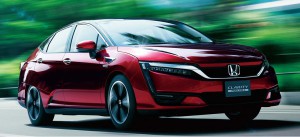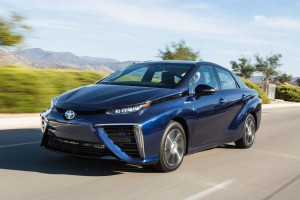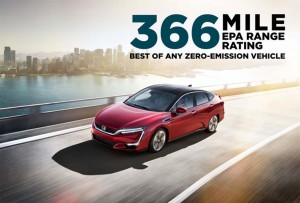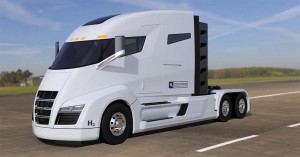
Honda's new Clarity fuel-cell vehicle is part of an onslaught of the vehicles that have hit U.S. roads in the last 18 months.
Honda delivered the first of its new fuel-cell vehicles to U.S. customers on Monday, becoming the third automaker to enter the hydrogen car market.
But as with Toyota and Hyundai, sales of the new Honda Clarity Fuel-Cell Vehicle will be limited to select portions of California, including Orange County, San Francisco and Sacramento, where a public supply of hydrogen is readily available.
The lack of a production and distribution network is considered the single-largest obstacle to widespread adoption of fuel-cell technology. But California and several other states are taking steps aimed at expanding availability of the clean fuel during the next decade.
The new Honda Clarity will be available for $369 a month for 36 months, with $2,868 due at signing. The pricing is in line with what Toyota is getting for its recently launched Mirai fuel-cell vehicle, as well as the Hyundai Tucson Fuel-Cell Vehicle launched in late 2015.
Honda originally intended to bring the Clarity to market a year ago but ran into delays, in part, due to shifts in internal engineering resources, several insiders have told TheDetroitBureau.com.
The third-largest Japanese automaker was actually the first to bring a hydrogen car to the U.S. retail market, though it only leased a total of 46 of the original Honda Clarity FCX models between 2008 and 2014 – and at a price of $600 a month.
Fuel-cell vehicles combine hydrogen with oxygen from the air in a device called a stack. That creates a flow of current that can be used to power the same type of electric motors used in a battery-only car, The only byproduct is water vapor. As a result, hydrogen cars and electric vehicles are the only products that meet the rigid zero-emissions vehicle, or ZEV, mandates in place in California and a handful of other states.
Both ZEV technologies have their drawbacks. Battery-electric vehicles have been expensive, limited in range and slow to recharge, with motorists often forced to plan travel around the availability of recharges. The charging network is rapidly expanding, while range is increasing at the same time costs are dropping.

Toyota's Mirai fuel-cell vehicle was the second fuel cell-powered vehicle recently introduced in the U.S.
Hydrogen cars are also expensive, but they offer range similar to conventional gasoline-powered cars – about 300 miles per tank for the Honda Clarity. And a fill-up typically takes less than five minutes. But there are only a few dozen refueling stations in the country, most in Orange County or the greater San Francisco Bay region.
As a result, all three makers currently selling fuel-cell vehicles are carefully interviewing prospective owners, in some cases telling them to come back in the future when more hydrogen stations are available.
(What! You didn’t celebrate Hydrogen Day? Click Here to see what you missed.)
California legislators have approved funding for up to 100 public hydrogen stations, though the project has gone more slowly than expected, according to industry officials.
Even so, a number of other manufacturers, including Daimler AG and General Motors, are developing their own fuel-cell vehicles which could come to market by early in the coming decade.
Meanwhile, there is growing interest in using hydrogen power for other applications, including heavy-duty trucks. Toyota recently announced it would launch development of a truck development unit next year.
(For more on Toyota’s plans, Click Here.)
Earlier this month, a Salt Lake City start-up, Nikola Motor Co. unveiled a semi rig using a fuel-cell system capable of traveling up to 1,200 miles between fill-ups. Dubbed Nikola One, it gets the equivalent of twice the mileage of a conventional heavy-duty truck.
The start-up plans to begin production of the big rig by 2020, Nikola claiming it already has $3 billion in orders in hand. The company also said it will set up its own hydrogen distribution network around the country – much in line with what Tesla Motors has done with its proprietary Supercharger network. The cost of the Nikola One will include all the hydrogen customers can use.
Some observers believe that the push for heavy truck applications could also help fuel interest in hydrogen passenger cars.
(For more on Nikola One, Click Here.)


